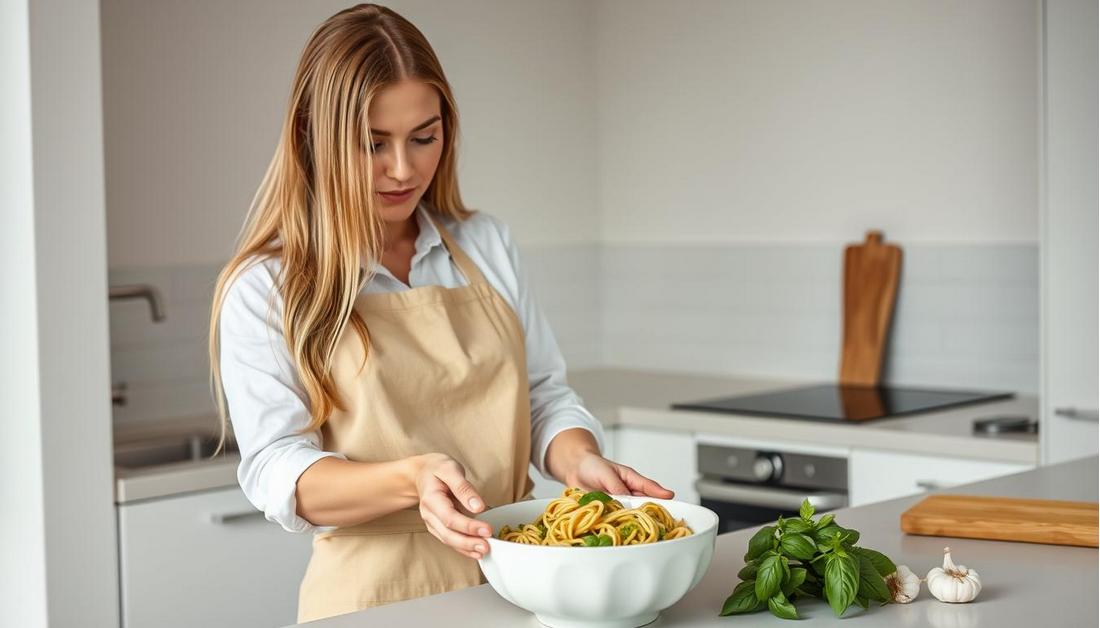India customers to view on amazon.in
Pesto Pasta Done Right: A Flavor Explosion
Discover the secret to creating an authentic Italian dish that bursts with flavor. Making Pesto Pasta is an art that requires fresh, high-quality ingredients and a bit of know-how.
- The Rich History of Pesto: From Genoa to Your Kitchen
- Essential Ingredients for Authentic Pesto Pasta
- The Foundation: Fresh Basil Leaves
- Pine Nuts: The Traditional Choice
- Choosing the Right Cheese
- Olive Oil Quality Matters
- Selecting the Perfect Pasta for Your Pesto
- Pesto Pasta Done Right: A Flavor Explosion
- Step-by-Step Pesto Preparation
- Cooking Pasta to Perfection
- Combining Pasta and Pesto: Techniques for Maximum Flavor
- Common Pesto Pasta Mistakes and How to Avoid Them
- Overheating Your Pesto
- Using Stale or Low-Quality Ingredients
- Improper Storage Techniques
- Pasta Preparation Errors
- Delicious Variations on Classic Pesto
- Elevating Your Pesto Pasta with Perfect Pairings
- Wine Pairings for Pesto Pasta
- Side Dishes That Complement Pesto Flavors
- Protein Additions for a Complete Meal
- Health Benefits of Pesto Ingredients
- Conclusion: Mastering the Art of Perfect Pesto Pasta
- FAQ
- What is the traditional pasta shape for Pesto?
- Can I use other types of nuts instead of pine nuts in Pesto?
- How do I store fresh basil to keep it fresh for longer?
- What’s the difference between Parmigiano-Reggiano and Pecorino cheese in Pesto?
- Can I make Pesto without a mortar and pestle?
- How do I achieve the perfect al dente texture when cooking pasta?
- Why is reserving pasta water important when making Pesto Pasta?
- Can I add protein to Pesto Pasta to make it a complete meal?
- How can I vary the traditional Pesto recipe?
- What are some common mistakes to avoid when making Pesto Pasta?
- What are the health benefits of Pesto ingredients?

With its rich history and simple preparation techniques, Pesto Pasta Done Right is a culinary experience everyone can enjoy. Whether you’re a seasoned chef or a kitchen novice, this guide will walk you through the process of crafting a deliciously authentic Italian cuisine dish.
Key Takeaways
- Learn the importance of using fresh, high-quality ingredients for the best flavor.
- Understand the history and origins of Pesto Pasta.
- Master the simple preparation techniques for an authentic Italian dish.
- Discover tips for achieving the perfect balance of flavors.
- Get the best Pesto Pasta recipe to try at home.
The Rich History of Pesto: From Genoa to Your Kitchen
Pesto’s rich history is deeply intertwined with the culinary traditions of Liguria, a region in northwest Italy. This beloved sauce has its roots in the region’s agricultural practices and culinary heritage.
Origins in Liguria, Italy
Pesto originated in Liguria, where the ingredients were readily available. The original recipe, known as Pesto alla Genovese, consisted of fresh basil, garlic, pine nuts, Parmesan cheese, and olive oil. These ingredients were crushed together using a mortar and pestle, creating a vibrant green sauce. The name “pesto” comes from the Italian word “pestare,” meaning to pound or crush, referring to the traditional method of preparation.

Evolution of Pesto Through the Centuries
As Italian cuisine evolved, so did pesto. The sauce gained popularity beyond Liguria, adapting to local tastes and ingredients. While traditional Pesto alla Genovese remains unchanged, variations have emerged, incorporating different herbs and nuts. Despite these changes, the essence of pesto remains tied to its Ligurian roots, celebrating the region’s rich culinary history.
Essential Ingredients for Authentic Pesto Pasta
Crafting authentic Pesto Pasta requires a deep understanding of its essential components. The quality and authenticity of Pesto Pasta are directly related to the freshness and type of ingredients used.
The Foundation: Fresh Basil Leaves
Fresh basil leaves are the cornerstone of authentic Pesto Pasta. Their vibrant flavor and aroma define the dish’s character. High-quality basil is essential for achieving the best taste.
Selecting and Storing Basil
Choose bright green, fresh leaves and store them properly to maintain their flavor. Basil can be stored in the refrigerator or frozen for later use.
Pine Nuts: The Traditional Choice
Pine nuts have been the traditional choice for Pesto Pasta due to their unique texture and rich, nutty flavor. They add depth to the dish.
Choosing the Right Cheese
The choice between Parmigiano-Reggiano and Pecorino cheese can significantly impact the flavor profile of Pesto Pasta. Parmigiano-Reggiano offers a nutty, salty taste, while Pecorino provides a tangy, sheep’s milk flavor.
Parmigiano-Reggiano vs. Pecorino
Understanding the differences between these cheeses is crucial. Parmigiano-Reggiano is often preferred for its umami flavor, but Pecorino adds a unique twist.
Olive Oil Quality Matters
The quality of olive oil used in Pesto Pasta is crucial as it brings all the flavors together. Extra virgin olive oil is recommended for its rich, fruity flavor and smooth texture.
| Ingredient | Importance | Tips |
|---|---|---|
| Fresh Basil Leaves | Foundation of the dish | Choose bright green leaves, store properly |
| Pine Nuts | Adds texture and flavor | Use traditional pine nuts for authenticity |
| Cheese | Impacts flavor profile | Choose between Parmigiano-Reggiano and Pecorino |
| Olive Oil | Brings flavors together | Use high-quality extra virgin olive oil |

Selecting the Perfect Pasta for Your Pesto
The right pasta shape can elevate your Pesto Pasta to new heights. Traditionally, certain pasta shapes are preferred for Pesto due to their ability to hold onto the sauce.
Traditional Pasta Shapes for Pesto
In Liguria, the birthplace of Pesto, specific pasta shapes are favored for their compatibility with the sauce. As Giulia Scarpaleggia, a renowned Italian food expert, once said, “The shape of the pasta is not just about aesthetics; it’s about how well it marries with the sauce.”
Trofie: The Authentic Ligurian Choice
Trofie pasta is the traditional choice in Liguria. Its twisted shape and rough texture make it ideal for holding Pesto sauce. The nooks and crannies in Trofie pasta trap the flavorful sauce, ensuring each bite is full of taste.
Other Excellent Options
While Trofie is authentic, other pasta shapes like linguine and fusilli also work well with Pesto. Linguine’s long, flat shape allows the sauce to cling to it, while fusilli’s corkscrew shape traps the Pesto, making each bite flavorful.
Texture Considerations for Maximum Flavor
The texture of the pasta plays a significant role in the overall experience. A good Pesto Pasta balances the smoothness of the sauce with the texture of the pasta. As a general rule, the pasta should be cooked al dente to provide a satisfying bite that complements the creamy Pesto sauce.

Pesto Pasta Done Right: A Flavor Explosion
Pesto pasta, when done right, is a culinary delight that bursts with flavor, thanks to the perfect balance of its ingredients. The key to achieving this balance lies in understanding the science behind pesto’s flavor profile.
The Science Behind Pesto’s Flavor Profile
Pesto’s flavor is a complex interplay of its main ingredients: basil, pine nuts, garlic, Parmesan cheese, and olive oil. Basil provides the fresh, herbaceous note, while pine nuts add a rich, nutty flavor. Garlic contributes a pungency that enhances the overall aroma, and Parmesan cheese adds a salty, umami taste. Finally, olive oil brings everything together, adding a smooth texture and fruity undertones.

Balancing Flavors for Maximum Impact
To achieve a flavor explosion in your pesto pasta, it’s crucial to balance these ingredients. Here are some tips:
- Use fresh, high-quality ingredients to ensure vibrant flavors.
- Adjust the amount of garlic according to your taste, as it can quickly overpower the dish.
- Don’t overprocess the pesto, as this can lead to a bitter taste and unappealing color.
- Toss the pasta with pesto at the right temperature to ensure the sauce coats the pasta evenly.
By mastering the balance of flavors, you’ll be able to create a pesto pasta dish that’s not only delicious but also a true representation of Italian culinary excellence.
Step-by-Step Pesto Preparation
Making pesto is a simple yet nuanced process that can elevate your pasta dishes significantly. Whether you’re a traditionalist or prefer modern conveniences, preparing pesto from scratch is a rewarding experience.
Preparing Your Fresh Ingredients
The foundation of great pesto lies in its fresh ingredients. Start by selecting fresh basil leaves, ensuring they are free from blemishes and have a vibrant green color. Next, choose high-quality pine nuts or your preferred nut substitute. Freshly grate Parmesan cheese to avoid preservatives found in pre-grated cheese. Finally, have extra virgin olive oil ready to bind the ingredients together.

The Traditional Hand Method
The traditional hand method involves using a mortar and pestle to grind the ingredients together, releasing their flavors and oils. This technique requires patience but yields a rich, authentic pesto.
Mortar and Pestle Technique
Begin by adding a handful of basil leaves to the mortar and gently crushing them with the pestle to release their oils. Gradually add more basil, pine nuts, and garlic, crushing and mixing between each addition. Finally, incorporate the Parmesan cheese and olive oil, mixing until you achieve the desired consistency.
Modern Food Processor Technique
For a quicker alternative, use a food processor to make pesto. Combine basil leaves, pine nuts, and garlic in the processor and pulse until coarsely chopped. Then, add Parmesan cheese and process until well combined. With the processor running, slowly pour in the olive oil through the feed tube until the pesto reaches your desired consistency.
Cooking Pasta to Perfection
Achieving perfectly cooked pasta is a crucial step in creating an exceptional Pesto Pasta dish. The process involves more than just boiling; it’s about understanding the nuances that make a difference.
Salt: The Flavor Enhancer
The importance of properly salted water cannot be overstated. Salting the water liberally before adding pasta not only seasons it but also helps to enhance its natural flavor. A general rule of thumb is to use about 1-2 tablespoons of salt for every 4 cups of water. This step is crucial as it sets the foundation for a flavorful Pesto Pasta.
The Al Dente Advantage
Cooking pasta al dente is vital for achieving the perfect texture. Al dente, which translates to “to the tooth,” means the pasta should have a slight firmness when bitten into. Timing is everything here; overcooking can lead to a mushy, unappetizing texture. Most pasta packages provide a guideline, but it’s essential to check a minute or two before the recommended time.
The Secret Ingredient: Pasta Water
Reserving some pasta water before draining is a trick that can elevate your Pesto Pasta. The starchy water helps to create a silky sauce that clings to the pasta perfectly. It’s a simple step that makes a significant difference in the overall quality of the dish.
| Cooking Technique | Benefit |
|---|---|
| Properly Salted Water | Enhances pasta flavor |
| Cooking Al Dente | Provides perfect texture |
| Reserving Pasta Water | Creates silky sauce |

Combining Pasta and Pesto: Techniques for Maximum Flavor
To achieve the perfect Pesto Pasta, it’s crucial to understand how to combine the pasta and Pesto effectively. This involves considering several factors that can elevate your dish from good to great.
Temperature Considerations
The temperature at which you combine pasta and Pesto can significantly impact the final dish. Ideally, the pasta should be hot, as this helps to slightly warm the Pesto, making it easier to mix. However, be cautious not to overheat the Pesto, as high temperatures can cause it to lose its vibrant color and some of its flavor. A good practice is to add the Pesto to the pasta immediately after draining, when the pasta is still steaming hot.
Proper Mixing Methods
The method you use to mix the pasta and Pesto is crucial. You want to ensure that the Pesto coats the pasta evenly without leaving clumps. Using a large serving bowl, gently toss the pasta with the Pesto using a pair of tongs or a large fork. This gentle mixing helps to distribute the Pesto sauce uniformly. Be gentle to avoid breaking the pasta.
Adding Pasta Water for the Perfect Consistency
One of the secrets to achieving the perfect Pesto Pasta consistency is adding some of the reserved pasta water. This starchy water helps to thin out the Pesto sauce, making it cling to the pasta more effectively. Start with a small amount, such as a quarter cup, and add more as needed until you achieve your desired consistency.
| Technique | Description | Benefit |
|---|---|---|
| Temperature Control | Combine hot pasta with Pesto | Enhances flavor integration |
| Gentle Mixing | Toss pasta gently with Pesto | Ensures even coating |
| Pasta Water Addition | Add reserved pasta water | Achieves perfect sauce consistency |

Common Pesto Pasta Mistakes and How to Avoid Them
The art of making perfect pesto pasta lies in avoiding common pitfalls that can ruin the dish’s overall taste and texture. Even experienced cooks can fall into traps that compromise the quality of this beloved Italian dish.
Overheating Your Pesto
One of the most common mistakes is overheating the pesto, which can cause it to lose its vibrant color and delicate flavor. To avoid this, gently warm the pesto over low heat or mix it with the hot pasta immediately before serving.
Tip: Never boil pesto or leave it in a hot pan for too long, as this can destroy its essential oils.
Using Stale or Low-Quality Ingredients
The quality of your ingredients directly impacts the taste of your pesto pasta. Using stale basil, old pine nuts, or low-quality cheese can result in a subpar dish. Always opt for fresh, high-quality ingredients to ensure the best flavor.
“The quality of your ingredients is paramount. Fresh basil, good-quality olive oil, and proper cheese make all the difference.”
Improper Storage Techniques
Improper storage can lead to a loss of freshness and flavor. Store pesto in an airtight container, cover it with a layer of olive oil, and keep it in the refrigerator to maintain its quality.
- Use airtight containers to prevent air exposure.
- Cover with olive oil to prevent oxidation.
- Refrigerate to slow down the degradation process.
Pasta Preparation Errors
Overcooking or undercooking pasta can significantly affect the final dish. Cook pasta al dente, and reserve some pasta water before draining to achieve the perfect sauce consistency.
| Pasta Texture | Cooking Time | Result |
|---|---|---|
| Al Dente | 8-10 minutes | Perfect texture, retains some firmness |
| Overcooked | More than 10 minutes | Mushy, unappetizing texture |
| Undercooked | Less than 8 minutes | Hard, crunchy texture |

Delicious Variations on Classic Pesto
Exploring different pesto variations can breathe new life into a classic recipe, offering a world of flavors beyond the traditional basil and garlic. This versatility is what makes pesto so beloved, as it can be adapted to suit various tastes and ingredients.
Sun-Dried Tomato Pesto
One delightful twist on traditional pesto is incorporating sun-dried tomatoes. This variation adds a rich, savory flavor that complements the brightness of fresh basil. To make sun-dried tomato pesto, simply blend sun-dried tomatoes with basil, garlic, pine nuts, Parmesan, and olive oil.
Arugula and Walnut Pesto
For a peppery twist, consider making arugula and walnut pesto. Arugula’s slightly bitter taste pairs beautifully with the earthy flavor of walnuts, creating a pesto that’s both complex and delicious. This variation works well with a variety of pasta shapes.
Cilantro and Pepita Pesto
Cilantro and pepita pesto offers a fresh and vibrant alternative to traditional pesto. The citrusy flavor of cilantro combined with the nutty taste of pepitas (pumpkin seeds) creates a pesto that’s perfect for those looking for a lighter, herbaceous flavor profile.
Mint and Pistachio Pesto
Another refreshing variation is mint and pistachio pesto. The cooling effect of mint paired with the rich, nutty flavor of pistachios makes for a delightful and unique pesto. This is particularly enjoyable during warmer months or as a palate cleanser between courses.
These variations on classic pesto not only showcase the versatility of this beloved sauce but also offer a range of flavors to suit different tastes and preferences. Whether you’re looking to add a bit of sunshine with sun-dried tomatoes or a refreshing zing with mint, there’s a pesto variation out there for everyone.
Elevating Your Pesto Pasta with Perfect Pairings
The art of enjoying Pesto Pasta lies in its perfect pairings and additions. To create a well-rounded dining experience, it’s essential to consider what accompanies your Pesto Pasta.
Wine Pairings for Pesto Pasta
When it comes to wine pairings, a crisp and refreshing white wine is often the best match for Pesto Pasta. Varieties like Pinot Grigio or Sauvignon Blanc complement the herbal notes of basil without overpowering the dish.
Side Dishes That Complement Pesto Flavors
Side dishes can add variety and depth to your meal. Grilled vegetables or a simple green salad with a light vinaigrette dressing are excellent choices. They not only complement the flavors of Pesto Pasta but also add a nutritious element to the meal.
| Side Dish | Description |
|---|---|
| Grilled Vegetables | Seasonal vegetables grilled to perfection |
| Green Salad | Fresh greens with a light vinaigrette |
Protein Additions for a Complete Meal
To turn Pesto Pasta into a complete meal, consider adding protein. Grilled chicken or shrimp are popular choices that pair well with Pesto. For a vegetarian option, tofu can be a great addition.
Health Benefits of Pesto Ingredients
Beyond its delicious taste, Pesto offers numerous health benefits thanks to its wholesome ingredients. The combination of basil, olive oil, nuts, and cheese creates a nutrient-rich sauce that can be a healthy addition to your meals.
Nutritional Profile of Basil
Basil is rich in antioxidants and has anti-inflammatory properties. It’s also a good source of vitamins A, C, and K. The antioxidants in basil help protect against cell damage, contributing to overall health and potentially reducing the risk of chronic diseases.
Heart-Healthy Olive Oil
Olive oil, a key component of Pesto, is renowned for its heart-healthy fats. Rich in monounsaturated fats, olive oil can help lower total cholesterol and LDL (“bad”) cholesterol levels, reducing the risk of heart disease.
Protein and Healthy Fats from Nuts and Cheese
Nuts and cheese in Pesto provide a boost of protein and healthy fats. Pine nuts, for example, are a good source of magnesium, while Parmesan cheese adds a rich source of calcium. Together, they contribute to a balanced diet, supporting muscle health and satiety.
Incorporating Pesto into your diet can be a flavorful way to enhance your nutritional intake. With its blend of nutrient-dense ingredients, Pesto pasta can be both a delicious and healthy meal option.
Conclusion: Mastering the Art of Perfect Pesto Pasta
Mastering pesto pasta is a culinary journey that involves understanding the rich history, selecting the finest ingredients, and employing precise preparation techniques. By avoiding common mistakes and exploring variations, you can create a dish that is both authentic and delicious.
With the knowledge gained from this article, you’re well on your way to creating perfect pesto pasta that showcases your culinary skill. The key is to balance flavors, use high-quality ingredients, and cook your pasta to perfection. As you continue to practice, you’ll develop your own signature pesto pasta recipe that will impress family and friends.
In conclusion, the art of making perfect pesto pasta is a skill that can be mastered with patience and practice. By following the guidelines outlined in this article, you’ll be able to create a truly exceptional dining experience. Whether you’re a seasoned chef or a culinary novice, mastering pesto pasta is a rewarding experience that will elevate your cooking to new heights.
FAQ
What is the traditional pasta shape for Pesto?
Trofie is the traditional Ligurian pasta shape for Pesto, as it’s designed to hold onto the sauce perfectly.
Can I use other types of nuts instead of pine nuts in Pesto?
Yes, you can use other nuts like walnuts, almonds, or pistachios, but pine nuts provide a unique flavor and texture.
How do I store fresh basil to keep it fresh for longer?
To keep fresh basil fresh, store it in a cool, dry place, or wrap it in a damp paper towel and refrigerate.
What’s the difference between Parmigiano-Reggiano and Pecorino cheese in Pesto?
Parmigiano-Reggiano has a nuttier, more mature flavor, while Pecorino is sharper and saltier; both work well in Pesto.
Can I make Pesto without a mortar and pestle?
Yes, you can make Pesto using a food processor, which is a quicker and more convenient method.
How do I achieve the perfect al dente texture when cooking pasta?
Cook pasta until it’s tender but still firm to the bite, then immediately drain and reserve some pasta water.
Why is reserving pasta water important when making Pesto Pasta?
Reserving pasta water helps to achieve the perfect consistency for the Pesto sauce, as it can be added to loosen the sauce if needed.
Can I add protein to Pesto Pasta to make it a complete meal?
Yes, adding protein like grilled chicken, shrimp, or tofu can turn Pesto Pasta into a satisfying and complete meal.
How can I vary the traditional Pesto recipe?
You can experiment with different ingredients like sun-dried tomatoes, arugula, or cilantro to create unique Pesto variations.
What are some common mistakes to avoid when making Pesto Pasta?
Common mistakes include overheating Pesto, using stale or low-quality ingredients, and improper storage techniques.
What are the health benefits of Pesto ingredients?
Pesto ingredients like basil, olive oil, nuts, and cheese offer antioxidants, heart-healthy fats, and protein, making Pesto Pasta a nutritious meal option.







